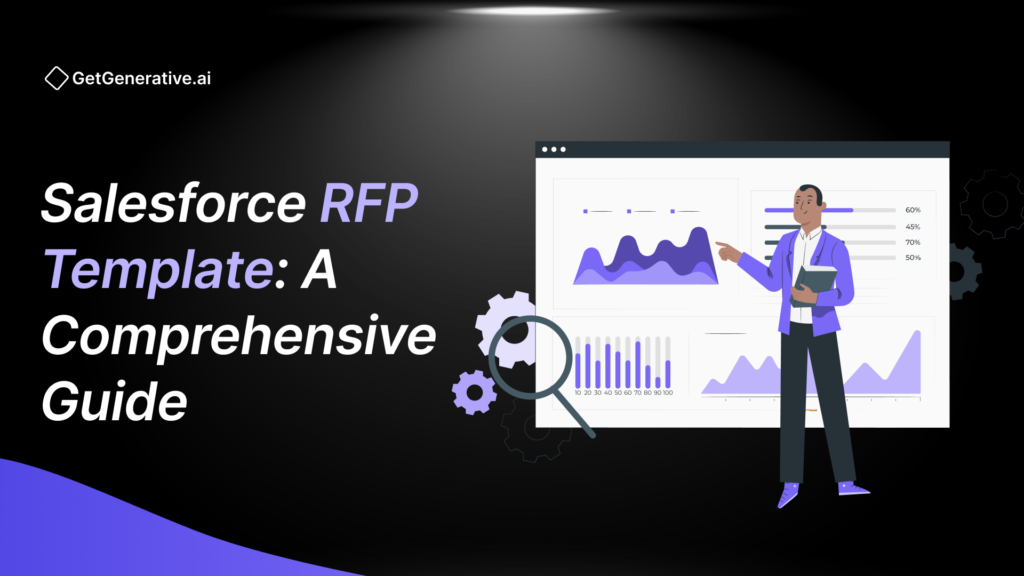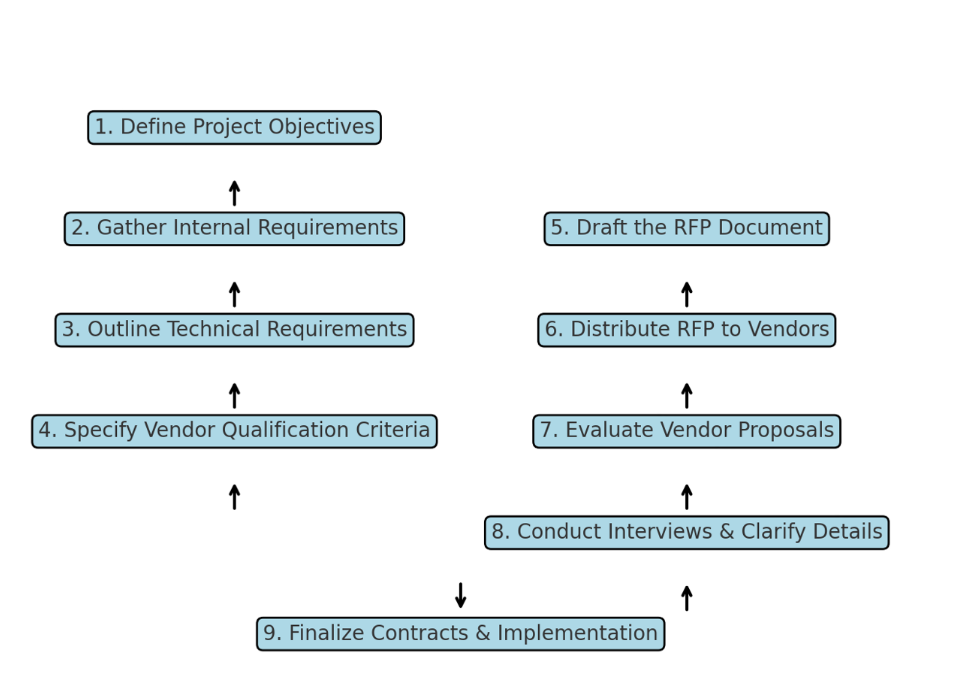Salesforce RFP Template: A Comprehensive Guide 2025
When selecting the right vendor for your Salesforce CRM implementation, creating a well-crafted Request for Proposal (RFP) is not just beneficial but essential. An RFP that accurately and clearly outlines your needs will attract competent vendors who can provide tailored solutions, ensuring your investment in Salesforce aligns perfectly with your business goals.
Jumping from a win rate of 38% last year to 42% this year, Small & Midsize companies (1 to 500 employees) gain impressive ground. Larger companies hold an advantage in the sales cycle because more prominent companies are often well-known and have more offerings and resources. This competitive landscape means that organizations not only have to choose from a larger pool of vendors but also must ensure that the selected vendor can scale with their evolving needs.
This guide walks you through creating a Salesforce RFP that facilitates a comprehensive and objective vendor evaluation process, setting you up for a successful partnership that enhances your customer relationship management (CRM) processes and drives growth in your organization.
Understanding the Importance of a Salesforce RFP
A well-constructed Salesforce RFP sets the stage for attracting competent vendors and serves as a strategic tool that ensures a fit-for-purpose implementation. Clearly detailing what you need will streamline the vendor evaluation process, leading to more effective and efficient project outcomes. The RFP documents your requirements and serves as a benchmark against which to measure vendor proposals.
This structured approach is essential for comparing solutions like-for-like, ensuring transparency and fairness in the selection process.
Related Reading: RFP for Salesforce Implementation: A Comprehensive Guide
Defining Your Objectives and Requirements
- Business Goals: Clearly articulate the business objectives you aim to achieve with Salesforce, such as increased sales productivity, improved customer service, or enhanced marketing automation.
- Challenges and Solutions: List specific challenges your business faces that Salesforce needs to address. For example, if lead conversion rates are low, you may require advanced analytics and lead-scoring features.
- Feature Set: Specify the essential features and functionalities, such as dashboard customization, report generation, or third-party integration capabilities. This helps ensure the proposed solutions meet your exact business needs.
Providing a Company Overview
- Company Background: Offer a brief company history, major achievements, and core business areas.
- Industry and Market: Describe your industry and any regulatory considerations that might affect the CRM implementation.
- Company Size and Geography: Detail the size of your company and the geographic locations where Salesforce will be deployed. These factors may impact your choice of a cloud-based or on-premises solution.
Learn more: Salesforce RFP Templates
Specifying Technical Requirements
- User Base: Specify the number of expected Salesforce users and their roles within your organization.
- Deployment Model: Based on your company’s IT policy and infrastructure, choose between a cloud-based solution and an on-premises installation.
- Integrations and Data Migration: Detail the existing systems (like ERP or email marketing tools) that Salesforce needs to integrate with. Outline the data migration requirements to ensure a smooth transition.
Defining Project Scope and Timeline
- Initial Modules: List the Salesforce modules (e.g., Sales Cloud, Service Cloud) you want to implement in the initial phase.
- Future Expansion: Mention any plans for future enhancements or additions to the system.
- Timeline: Provide a detailed timeline for the implementation, including milestones like the completion of phases, training, and go-live dates.
Requesting Vendor Qualifications and Experience
- Certifications: Request information on Salesforce certifications held by the vendor’s team.
- Industry Experience: Ask for examples of Salesforce implementations the vendor has completed in similar industries.
- Client References: Require references or case studies from past clients, particularly those with similar scope or challenges.
Case Study: A Mid-Sized Tech Company’s Success
A mid-sized tech company was struggling with low lead conversion rates and inefficient customer tracking. After issuing a well-structured RFP that clearly defined its goals and outlined vendor requirements, the company selected a Salesforce partner that specialized in lead management automation. As a result, they increased their sales productivity by 30% within the first six months of implementation.
Outlining Budget and Pricing Information
- Budget Range: Provide a clear budget range for the total cost of ownership, including all implementation and recurring expenses.
- Cost Breakdown: Ask for a detailed breakdown of costs, such as licensing fees, customization, support, and any additional tools or services required.
Evaluating Salesforce Support and Training
- Support Services: Evaluate the vendor’s support infrastructure. Ask about their SLAs, support hours, and communication channels.
- Training Resources: Assess the training resources available, such as user manuals, online tutorials, and hands-on sessions, to ensure your team can fully leverage the Salesforce platform.
Proposal Submission and Evaluation Process
- Submission Guidelines: Define the format, length, and content of the proposals, including key sections that must be addressed.
- Evaluation Criteria: Set clear criteria for evaluating the proposals, prioritizing vendor experience, technological fit, cost, and strategic alignment with your business objectives.
- Deadlines and Contacts: Specify the deadline for proposal submission and provide contact information for the person managing the RFP process.
Common Mistakes to Avoid When Creating a Salesforce RFP
1. Lack of Specificity
Providing vague or generalized requirements can lead to ambiguous responses. Clearly articulate your objectives, features, and technical needs to help vendors provide tailored solutions.
2. Overlooking Scalability
Failing to account for future growth can result in selecting a solution that cannot scale with your business. Include long-term goals and potential expansion plans to ensure the solution is adaptable.
3. Ignoring Budget Transparency
Not specifying a budget range can lead to proposals that are either over your budget or lack the necessary features due to cost constraints. Being upfront about your financial parameters helps vendors propose feasible solutions.
4. Insufficient Vendor Qualification Criteria
Choosing a vendor solely based on cost or vague qualifications can lead to challenges in implementation. Request details on certifications, industry experience, and client references to ensure the vendor’s credibility.
5. Underestimating Data Migration Complexity
Data migration is often more complex than anticipated. Clearly outline your current data landscape, volume, and any required transformations to avoid surprises during implementation.
6. Inadequate Emphasis on Training and Support
Overlooking the importance of training and support can reduce user adoption rates. Specify your expectations for user training and post-implementation support to ensure long-term success.
7. Unclear Evaluation Criteria
Failing to provide detailed evaluation criteria can make it difficult to objectively compare proposals. Define metrics like cost, technical expertise, and strategic alignment to streamline the decision-making process.
8. Rushing the RFP Timeline
Setting unrealistic deadlines for proposal submission can lead to incomplete or subpar responses. Allow sufficient time for vendors to craft comprehensive proposals that address all your requirements.
9. Neglecting Stakeholder Involvement
Not involving key stakeholders during the RFP creation process can result in overlooked requirements or misaligned goals. Engage representatives from sales, marketing, IT, and other relevant departments.
10. Overlooking Compliance Requirements
Failing to emphasize compliance with industry regulations or data privacy standards can lead to legal and operational risks. Highlight specific compliance needs in your RFP.
Conclusion: Your Salesforce Success Starts with the Right RFP
Crafting a comprehensive Salesforce RFP is a crucial step in ensuring a successful CRM implementation. By clearly defining your needs, expectations, and evaluation criteria, you set the foundation for choosing the right vendor who can deliver value and drive growth. . A well-constructed RFP attracts the right vendors and ensures that the selected vendor is perfectly equipped to meet your business challenges, now and in the future.
Remember, the goal of the RFP is to foster a transparent and competitive bidding environment that yields the best match for your Salesforce implementation needs. Carefully craft this document; it is a fundamental step in transforming your customer engagement capabilities.
Learn more about vendor qualifications and RFP management
Sign up with GetGenerative.ai today! Our platform helps you create strong proposals quickly, letting you focus on great results for your clients.
Make your work easier and better with us.
Frequently Asked Questions (FAQs)
1. What is a Salesforce RFP?
A Salesforce RFP (Request for Proposal) is a document that outlines your business’s requirements for a Salesforce CRM implementation, inviting vendors to submit proposals that meet these needs.
2. Why is a Salesforce RFP important?
A well-crafted RFP ensures that you find a vendor who meets your technical requirements, understands your business goals, and can offer a tailored Salesforce solution.
3. What should be included in a Salesforce RFP?
Your RFP should include objectives and requirements, company overview, technical requirements, project scope, timeline, vendor qualifications, budget details, support and training expectations, and proposal submission guidelines.
4. How do I evaluate Salesforce RFP responses?
Evaluate responses based on criteria like technical expertise, relevant experience, cost, vendor reputation, and alignment with the RFP’s requirements.
5. What are the key benefits of using a Salesforce RFP?
Using an RFP for your Salesforce project can help you make an informed decision, ensure alignment with business goals, and foster competitive and transparent vendor selection.





